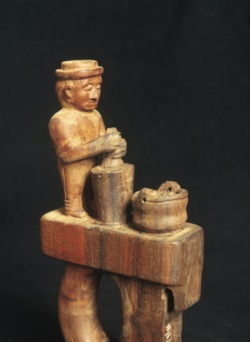Oľga Danglová
The depiction of the human body or its part in folk art originally was believed to have magical powers, which transferred from the pre-Christian cult to Christian cult. This magical sense of depicting a figure ceased over time, and the figural element became part of ornamental composition such as décor or illustration. The geometrical abstraction of human figures in the decorative tradition does not often appear in Slovakia, although it is founds more often for example in carved forms on chests and weaved patterns from the Gemer region, in counted embroidery made through folds, and in cross stitching. The figures obtained more natural depiction when they were part of floral composition. The theme of anthropomorphic depictions was usually connected to the character and use of the object. For example, on so-called love gifts – dollies, spindles and Easter eggs – the human couple, two people in love were depicted. Figures carved by shepherds on wooden utensils, shepherd crooks and musical instruments were naturally figures of shepherds and highwaymen. Decoration on miner’s axes not surprisingly depicted miners. The popularity of more realistically depicted figures was influenced by the patterns of professional craft designs on honey cakes, blue print and vessels from guilds. The object could also have a plastically shaped head or human body (on gate posts, wooden tools, sticks and pipes). Individually a human body can be found most often on statues, honey cake forms, Nativity figures and glass paintings. In the 18th and 19th centuries, the depiction of figures was concentrated mainly on religious topics, but during the 19th century figures of farmers, shepherds, craftsmen working with tools, hunters and highwaymen start to enter the folk repertoire. The figures of elegant couples, ladies and gentlemen in historical costumes were in Slovakia more often depicted on honey cakes and gift wax sculptures, in genre rococo depictions on paintings on ceramics and in blue print patterns. During the 20th century, scenes from everyday life as well as celebrations in villages depicted for example on embroidered pictures became more significant.
